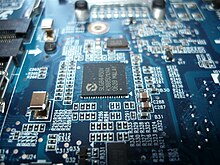"Electrical and computer engineering" redirects here. For contents about computer engineering, see Computer engineering.
Electrical engineering is a field of engineering that generally deals with the study and application of electricity, electronics, and electromagnetism. This field first became an identifiable occupation in the later half of the 19th century after commercialization of the electric telegraph, the telephone, and electric power distribution and use. Subsequently, broadcasting and recording media made electronics part of daily life. The invention of the transistor and, subsequently, the integrated circuit brought down the cost of electronics to the point where they can be used in almost any household object.
Electrical engineering has now subdivided into a wide range of subfields including electronics, digital computers, power engineering, telecommunications, control systems, RF engineering, signal processing, instrumentation, and microelectronics. The subject of electronic engineering is often treated as its own subfield but it intersects with all the other subfields, including the power electronics of power engineering.
Electrical engineers typically hold a degree in electrical engineering or electronic engineering. Practicing engineers may have professional certification and be members of aprofessional body. Such bodies include the Institute of Electrical and Electronic Engineers (IEEE) and the Institution of Engineering and Technology (IET).
Electrical engineers work in a very wide range of industries and the skills required are likewise variable. These range from basic circuit theory to the management skills required of project manager. The tools and equipment that an individual engineer may need are similarly variable, ranging from a simple voltmeter to a top end analyzer to sophisticated design and manufacturing software.
During the development of radio, many scientists and inventors contributed to radio technology and electronics. The mathematical work of James Clerk Maxwell during the 1850s had shown the relationship of different forms of electromagnetic radiation including possibility of invisible airborn waves (later called "radio waves"). In his classic physics experiments of 1888, Heinrich Hertz proved Maxwell's theory by transmitting radio waves with a spark-gap transmitter, and detected them by using simple electrical devices. Other physicists experimented with these new waves and in the process developed devices for transmitting and detecting them. In 1895 Guglielmo Marconi began work on a way to adapt the known methods of transmitting and detecting these "Hertzian waves" into a purpose built commercial wireless telegraphic system. Early on, he sent wireless signals over a distance of one and a half miles. In December 1901, he sent wireless waves that were not affected by the curvature of the Earth. Marconi later transmitted the wireless signals across the Atlantic between Poldhu, Cornwall, and St. John's, Newfoundland, a distance of 2,100 miles (3,400 km).[13]
In 1897, Karl Ferdinand Braun introduced the cathode ray tube as part of an oscilloscope, a crucial enabling technology for electronic television.[14] John Fleming invented the first radio tube, the diode, in 1904. Two years later, Robert von Lieben and Lee De Forest independently developed the amplifier tube, called the triode.[15]
In 1920 Albert Hull developed the magnetron which would eventually lead to the development of the microwave oven in 1946 by Percy Spencer.[16][17] In 1934 the British military began to make strides toward radar (which also uses the magnetron) under the direction of Dr Wimperis, culminating in the operation of the first radar station at Bawdsey in August 1936.[18]
In 1941 Konrad Zuse presented the Z3, the world's first fully functional and programmable computer using electromechanical parts. In 1943 Tommy Flowers designed and built theColossus, the world's first fully functional, electronic, digital and programmable computer.[19] In 1946 the ENIAC (Electronic Numerical Integrator and Computer) of John Presper Eckertand John Mauchly followed, beginning the computing era. The arithmetic performance of these machines allowed engineers to develop completely new technologies and achieve new objectives, including the Apollo program which culminated in landing astronauts on the Moon.[20]


No comments:
Post a Comment